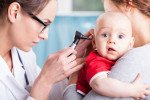Acupressure is a gentle therapy in which a person applies light pressure to specific areas of the body to relieve symptoms such as pain, nausea, and anxiety. Parents love to learn about acupressure because it’s a great way for them to interact with their children, a natural way to soothe a child’s discomfort, and easy to learn and use. Acupressure points are the same as acupuncture points but no needles are used and anyone can apply the pressure to the point.
Acupressure is safely administered by rubbing small circles around or tapping a specific point with a finger. Pressure or tapping should be light and soothing, and the length of time can be 10-30 seconds.
The pressure can vary to meet the needs of the person receiving it and benefit can still be achieved if you’re close to the desired acupressure point, so don’t worry about being too precise. There are few to no risks or contraindications with acupressure. Pressure that is too hard can bruise, but hard or deep pressure is not needed. Some acupressure points are contraindicated in pregnancy, as they could induce contractions. Parents and children can be taught to use acupressure points and are encouraged to use the points as often as two-three times a day.
Acupressure Pain Points:
1) Large Intestine 4 – On the top of the hand, in the web between the thumb and pointer finger (*contraindicated in pregnancy)
Good for: headache, neck pain or stiffness, tooth pain, eye twitches and/or eye issues.
2) Liver 3 – On the top of the foot, in the depression between the big toe and the second toe about ½ inch up on a child and an inch up on an adult. (*contraindicated in pregnancy)
Good for: leg pain, hip pain, sprained ankle, foot pain, menstrual disorders, headache, high blood pressure and/or abdomen discomfort.
Acupressure Digestion and Nausea Points:
3) Pericardium 6 – Three finger breadths above the inside crease of the wrist, right between the two central tendons.
Good for: nausea, abdomen pain, chest tightness, heart palpitations, difficulty breathing and or emotional upset.
4) Stomach 36 – Four finger breadths below the bottom of the knee cap and one finger breadth off the outside border of the shin bone.
Good for: stomach aches, abdomen pain, constipation, diarrhea, IBS, crones disease, chronic fatigue and/or decreased daily energy levels.
Acupressure Anxiety Point:
5) Du 20 – On the midline of the head, approximately on the midpoint of a line connecting the tip of both ears
Good for: lifting one’s spirit, anxiety, depression, anger, frustration, poor memory, poor focus and/or low blood pressure.
Acupressure is just one of the many complementary medical services offered to both inpatients and outpatients at Primary Children’s Hospital. Learn more about our Integrative Medicine clinic and how these customized services, such as massage or aroma therapy, might help your child.
About the Author
Share This Article
2 Comments
-

Paulette P
on November 12, 2015Seriously?! I’m appalled that a medical facility is promoting pseudo science. There is no science based evidence for this practice and any results are no better than placebo. Alternative medicine and practices such as these may not cause outright harm, but delaying actual care could be harmful and at times deadly. I am disappointed in Primary Children’s for endorsing and associating with such practices and I will think twice about ever taking my child to your hospital.
-

Primary Children's Hospital
on November 14, 2015Thank you for your feedback. We are aware that complementary medicine practices are not for everyone and agree with you that they should not be used in place of western medical care or as a delay in care mechanism. Primary Children’s Hospital prides itself on providing the highest standard of care and the best evidence-based medicine practices. The Integrative Medicine services we offer have been deeply researched, requested by many parents and patients and are widely accepted across the US as effective complementary medicine practice. What is best for your child, is always our first priority and if you, as a parent, do not think Integrative Medicine services are helpful we understand. It is just one of the many options we provide to patients as a compliment to their medical care. We encourage parents to talk to their child’s medical team about what therapies can best help their child live the healthiest life possible.
Search Our Blog
Our Instagram
Recent Posts
- How to Talk to Your Kids About Drugs January 22, 2016
- “In that Moment, There Was Light”: Music Therapy Brings Hope to Naomi January 8, 2016
- Ed Clark, MD, Steps Down as Chief Medical Officer of Primary Children’s Hospital January 6, 2016
- Pediatric Liver Transplant Program Celebrates 200 Lives Saved and 20 Years December 30, 2015
- Is it the Cold or the Flu? December 18, 2015
Our Most Popular Posts
 How to Talk to Your Kids About Drugs 18 views
How to Talk to Your Kids About Drugs 18 views  Youth Suicide Prevention: Help Save a Life 11 views
Youth Suicide Prevention: Help Save a Life 11 views  “In that Moment, There Was Light”: Music Therapy Brings Hope to Naomi 10 views
“In that Moment, There Was Light”: Music Therapy Brings Hope to Naomi 10 views  Why Kids Shouldn’t Wear Bulky Coats in Car Seats 9 views
Why Kids Shouldn’t Wear Bulky Coats in Car Seats 9 views  On Childhood Cancer: Perspectives of a Pediatric Oncologist 8 views
On Childhood Cancer: Perspectives of a Pediatric Oncologist 8 views  Wasatch Canyons Celebrates Opening of the LiVe Well Garden 7 views
Wasatch Canyons Celebrates Opening of the LiVe Well Garden 7 views  It’s Never Safe to Leave Your Child Alone in a Car 6 views
It’s Never Safe to Leave Your Child Alone in a Car 6 views  Pediatric Liver Transplant Program Celebrates 200 Lives Saved and 20 Years 6 views
Pediatric Liver Transplant Program Celebrates 200 Lives Saved and 20 Years 6 views  Orthopedic Care by the Numbers 6 views
Orthopedic Care by the Numbers 6 views  Ed Clark, MD, Steps Down as Chief Medical Officer of Primary Children’s Hospital 6 views
Ed Clark, MD, Steps Down as Chief Medical Officer of Primary Children’s Hospital 6 views
Archives
- January 2016 (3)
- December 2015 (5)
- November 2015 (8)
- October 2015 (8)
- September 2015 (2)
- August 2015 (1)
- July 2015 (3)
- June 2015 (2)
- May 2015 (2)
- March 2015 (3)
- February 2015 (2)
- January 2015 (2)
- November 2014 (1)
- October 2014 (1)
- September 2014 (3)
- August 2014 (2)
- July 2014 (4)
- June 2014 (2)
- May 2014 (4)
- April 2014 (6)
- March 2014 (4)
- February 2014 (1)
- September 2013 (1)
- February 2013 (1)
- June 2012 (1)














Add comment